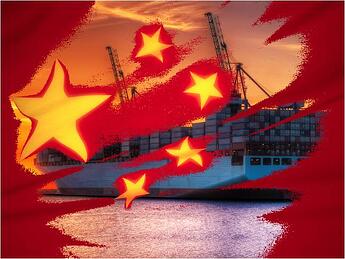Will China Rule International Shipping by 2030? Research Says Yes
China is going to dominate international shipping in 2030. Just ask them.

The Shanghai International Shipping Institute released a 2-year study called China Shipping Development Outlook 2030 that projects China to be the top shipping nation in the world. They’ll even own the largest cruise market according to the study.
You can buy a copy of the study for only $500. To help you decide if you want to shell out that kind of cash, we’ll give you a few highlights here.
Here are five ways the Shanghai International Shipping Institute says China will dominate:
1. Demand
By 2030, China’s total international shipping volume will reach 6.2bn tons, which will account for 17% of the world’s shipping volume.
2. Capacity
China is expected to exceed Greece in terms of total fleet capacity by 2030.
3. Port
Container throughput at Chinese ports will reach 505m TEU in 2030 with an average growth rate of about 6%.
4. Shipping finance and insurance
China’s ship financing will account for 30% of the world’s volume.
5. Cruise
China will be the world’s largest cruise market and Chinese shipyards are expected to get about 11% of the world’s cruise ship orders by the time.
The China Shipping Development Outlook 2030 has even “drawn a blueprint for the medium term future of China’s shipping industry” to help the country realize its international shipping dominance over the next 15 years.
Greg Knowler highlighted some of the ways Shanghai International Shipping Institute’s China Shipping Development Outlook 2030 advises China on the future of the international shipping industry in a Journal of Commerce (JOC) article about the research report:
The extensive report covers all areas of the country’s maritime industry and calls on the Chinese government to be “clear-minded” about what needs to be done, warning that industries against the general trend may eventually be eliminated.
“Enterprises will be faced with a more open shipping market, foreign capital will inevitably enter all areas of the shipping industry, and the monopoly-based interests enjoyed by some shipping and port sectors today will be affected by marketization,” the report noted.
“Chinese enterprises sometimes hope the government would keep their foreign counterparts outside, but the government will no longer interfere in areas where resource allocation should be market-based.”
In fact, Knowler’s article even shares how the report says the international shipping industry is on the brink of reform:
“Looking toward 2030, we should realize that the current shipping industry is on the eve of a major reform. The continuous recession in the shipping industry that we’ve felt is the prelude to this upcoming industrial reform. Innovative enterprises that can adapt to the changes will embrace growth by blazing out a new path, whereas enterprises that stick in a rut may not see the day of recovery,” the report stated.
That the international shipping industry is on the brink of change should come as no surprise to anyone. Carriers have struggled to make money in recent years, even suffering losses in the billions of dollars.
Change has already begun in the international shipping industry with the trends toward megaships and carrier alliances to bring down costs for the world’s giant shipping companies.
It also would not be all that surprising for the changes in international shipping to include China as the new leader of international shipping. China’s economic growth and in international shipping has dwarfed the growth of other countries, including the U.S., in terms of international trade in recent years.
However, China has not maintained the mammoth economic and world trade growth of recent years. In fact, “China’s export sales contracted 15 percent in March, a shock outcome that deepens concern about sputtering Chinese economic growth,” according to a recent Reuter’s article.
Still, the report looks at China’s import and export growth over the last 10 years and projects what that growth will look like in 2030. Here’s how Knowler’s JOC article summarizes it:
The report found that China’s import and export of container cargo had increased at an average annual rate of 12.13 percent in the past 10 years and was expected to pass 200 million TEUs in 2030. But in 2030, the containerised imports and exports would slow to an average growth rate of 4-5 percent a year. Its international container trade will take a larger global market share, imports and exports would be more balanced, imports would increase faster than exports, and products with higher values would comprise a larger proportion of exports.
I’ll end by sharing the top 10 ports of 2030. At least, these are the top 10 ports as projected by China Shipping Development Outlook 2030 that Marinelink.com then shared. I think it’s more fun to go David Letterman style and count down to the top port. Of course, this list won’t be as funny as a Letterman Top 10 list.
10. Xiamen (13.24 million TEUs)
9. Lianyungang (16.67 million TEUs)
8. Suzhou (23.11 million TEUs)
7. Dalian (27.86 million TEUs)
6. Guangzhou (30.07 million TEUs)
5. Shenzhen (30.24 million TEUs)
4. Tianjin (32.3 million TEUs)
3. Ningbo-Zhoushan (37.27 million TEUs)
2. Qingdao (43.15 million TEUs)
1. Shanghai (52.68 million TEUs)
What do you think? Will China dominate international shipping in 2030?
![]()
Source: China


